Mechanical Engineering: Vibration Testing of Gloves Report
VerifiedAdded on 2022/09/12
|7
|1112
|19
Report
AI Summary
This report presents a comprehensive analysis of vibration testing, specifically focusing on gloves used in mechanical engineering contexts to mitigate the effects of Hand-Arm Vibration Syndrome (HAVS). The study employs a methodology involving shaker mass monitoring and testing of gloves with holding cylinder tools at various orientations to measure force vibration motion. The report details two parallel testing streams, grip testing, and theoretical analysis using MATLAB software, along with relevant equations for motion and parameter calculations. It also outlines health, ethical, and safety responsibilities, including adherence to international standards (ISO 5349) and testing requirements. The results and conclusion emphasize the importance of the various parameters to reduce the risk of vibration at the workplace. References to relevant research papers are also included.

Mechanical Engg.
Paraphrase This Document
Need a fresh take? Get an instant paraphrase of this document with our AI Paraphraser
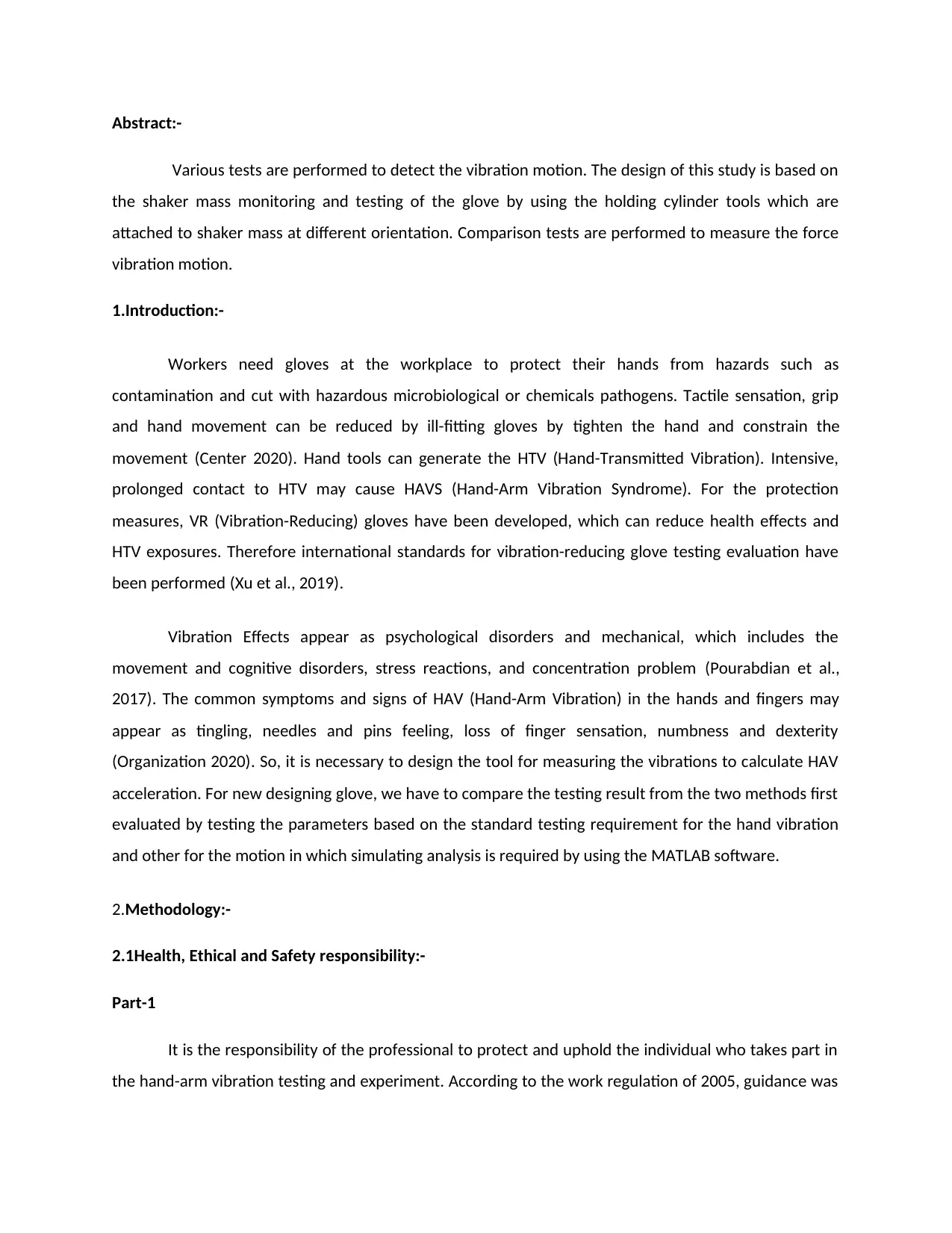
Abstract:-
Various tests are performed to detect the vibration motion. The design of this study is based on
the shaker mass monitoring and testing of the glove by using the holding cylinder tools which are
attached to shaker mass at different orientation. Comparison tests are performed to measure the force
vibration motion.
1.Introduction:-
Workers need gloves at the workplace to protect their hands from hazards such as
contamination and cut with hazardous microbiological or chemicals pathogens. Tactile sensation, grip
and hand movement can be reduced by ill-fitting gloves by tighten the hand and constrain the
movement (Center 2020). Hand tools can generate the HTV (Hand-Transmitted Vibration). Intensive,
prolonged contact to HTV may cause HAVS (Hand-Arm Vibration Syndrome). For the protection
measures, VR (Vibration-Reducing) gloves have been developed, which can reduce health effects and
HTV exposures. Therefore international standards for vibration-reducing glove testing evaluation have
been performed (Xu et al., 2019).
Vibration Effects appear as psychological disorders and mechanical, which includes the
movement and cognitive disorders, stress reactions, and concentration problem (Pourabdian et al.,
2017). The common symptoms and signs of HAV (Hand-Arm Vibration) in the hands and fingers may
appear as tingling, needles and pins feeling, loss of finger sensation, numbness and dexterity
(Organization 2020). So, it is necessary to design the tool for measuring the vibrations to calculate HAV
acceleration. For new designing glove, we have to compare the testing result from the two methods first
evaluated by testing the parameters based on the standard testing requirement for the hand vibration
and other for the motion in which simulating analysis is required by using the MATLAB software.
2.Methodology:-
2.1Health, Ethical and Safety responsibility:-
Part-1
It is the responsibility of the professional to protect and uphold the individual who takes part in
the hand-arm vibration testing and experiment. According to the work regulation of 2005, guidance was
Various tests are performed to detect the vibration motion. The design of this study is based on
the shaker mass monitoring and testing of the glove by using the holding cylinder tools which are
attached to shaker mass at different orientation. Comparison tests are performed to measure the force
vibration motion.
1.Introduction:-
Workers need gloves at the workplace to protect their hands from hazards such as
contamination and cut with hazardous microbiological or chemicals pathogens. Tactile sensation, grip
and hand movement can be reduced by ill-fitting gloves by tighten the hand and constrain the
movement (Center 2020). Hand tools can generate the HTV (Hand-Transmitted Vibration). Intensive,
prolonged contact to HTV may cause HAVS (Hand-Arm Vibration Syndrome). For the protection
measures, VR (Vibration-Reducing) gloves have been developed, which can reduce health effects and
HTV exposures. Therefore international standards for vibration-reducing glove testing evaluation have
been performed (Xu et al., 2019).
Vibration Effects appear as psychological disorders and mechanical, which includes the
movement and cognitive disorders, stress reactions, and concentration problem (Pourabdian et al.,
2017). The common symptoms and signs of HAV (Hand-Arm Vibration) in the hands and fingers may
appear as tingling, needles and pins feeling, loss of finger sensation, numbness and dexterity
(Organization 2020). So, it is necessary to design the tool for measuring the vibrations to calculate HAV
acceleration. For new designing glove, we have to compare the testing result from the two methods first
evaluated by testing the parameters based on the standard testing requirement for the hand vibration
and other for the motion in which simulating analysis is required by using the MATLAB software.
2.Methodology:-
2.1Health, Ethical and Safety responsibility:-
Part-1
It is the responsibility of the professional to protect and uphold the individual who takes part in
the hand-arm vibration testing and experiment. According to the work regulation of 2005, guidance was
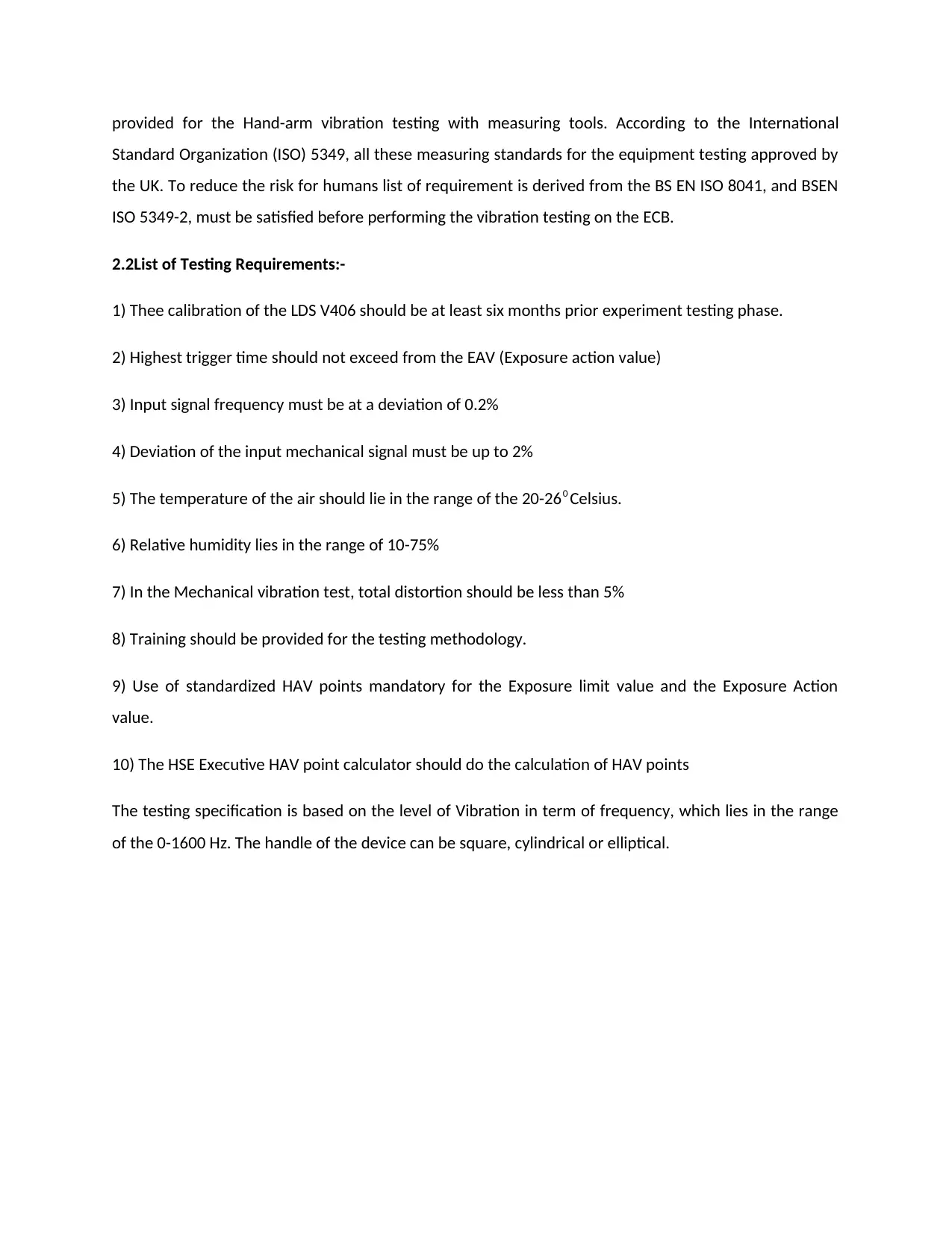
provided for the Hand-arm vibration testing with measuring tools. According to the International
Standard Organization (ISO) 5349, all these measuring standards for the equipment testing approved by
the UK. To reduce the risk for humans list of requirement is derived from the BS EN ISO 8041, and BSEN
ISO 5349-2, must be satisfied before performing the vibration testing on the ECB.
2.2List of Testing Requirements:-
1) Thee calibration of the LDS V406 should be at least six months prior experiment testing phase.
2) Highest trigger time should not exceed from the EAV (Exposure action value)
3) Input signal frequency must be at a deviation of 0.2%
4) Deviation of the input mechanical signal must be up to 2%
5) The temperature of the air should lie in the range of the 20-260 Celsius.
6) Relative humidity lies in the range of 10-75%
7) In the Mechanical vibration test, total distortion should be less than 5%
8) Training should be provided for the testing methodology.
9) Use of standardized HAV points mandatory for the Exposure limit value and the Exposure Action
value.
10) The HSE Executive HAV point calculator should do the calculation of HAV points
The testing specification is based on the level of Vibration in term of frequency, which lies in the range
of the 0-1600 Hz. The handle of the device can be square, cylindrical or elliptical.
Standard Organization (ISO) 5349, all these measuring standards for the equipment testing approved by
the UK. To reduce the risk for humans list of requirement is derived from the BS EN ISO 8041, and BSEN
ISO 5349-2, must be satisfied before performing the vibration testing on the ECB.
2.2List of Testing Requirements:-
1) Thee calibration of the LDS V406 should be at least six months prior experiment testing phase.
2) Highest trigger time should not exceed from the EAV (Exposure action value)
3) Input signal frequency must be at a deviation of 0.2%
4) Deviation of the input mechanical signal must be up to 2%
5) The temperature of the air should lie in the range of the 20-260 Celsius.
6) Relative humidity lies in the range of 10-75%
7) In the Mechanical vibration test, total distortion should be less than 5%
8) Training should be provided for the testing methodology.
9) Use of standardized HAV points mandatory for the Exposure limit value and the Exposure Action
value.
10) The HSE Executive HAV point calculator should do the calculation of HAV points
The testing specification is based on the level of Vibration in term of frequency, which lies in the range
of the 0-1600 Hz. The handle of the device can be square, cylindrical or elliptical.
⊘ This is a preview!⊘
Do you want full access?
Subscribe today to unlock all pages.

Trusted by 1+ million students worldwide
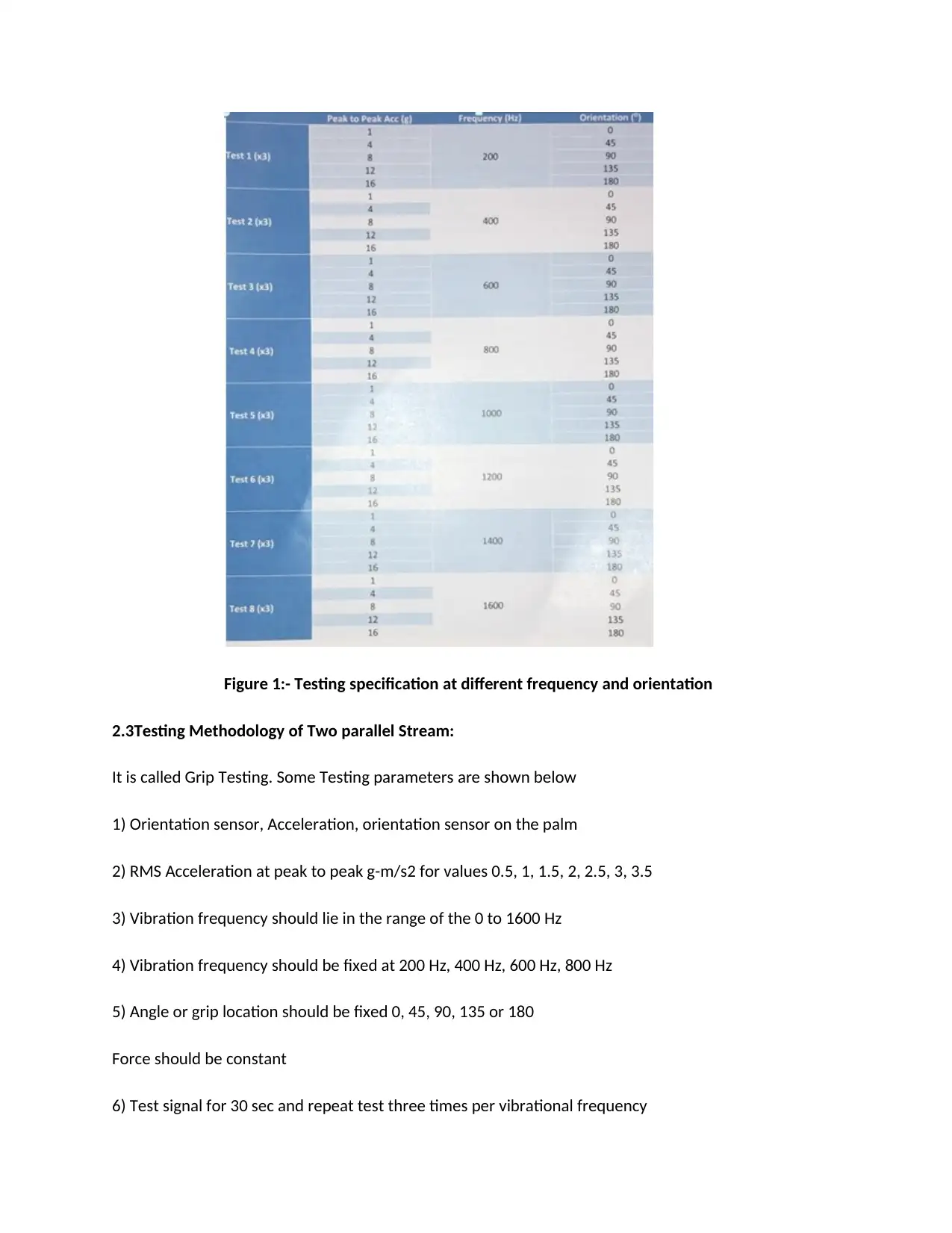
Figure 1:- Testing specification at different frequency and orientation
2.3Testing Methodology of Two parallel Stream:
It is called Grip Testing. Some Testing parameters are shown below
1) Orientation sensor, Acceleration, orientation sensor on the palm
2) RMS Acceleration at peak to peak g-m/s2 for values 0.5, 1, 1.5, 2, 2.5, 3, 3.5
3) Vibration frequency should lie in the range of the 0 to 1600 Hz
4) Vibration frequency should be fixed at 200 Hz, 400 Hz, 600 Hz, 800 Hz
5) Angle or grip location should be fixed 0, 45, 90, 135 or 180
Force should be constant
6) Test signal for 30 sec and repeat test three times per vibrational frequency
2.3Testing Methodology of Two parallel Stream:
It is called Grip Testing. Some Testing parameters are shown below
1) Orientation sensor, Acceleration, orientation sensor on the palm
2) RMS Acceleration at peak to peak g-m/s2 for values 0.5, 1, 1.5, 2, 2.5, 3, 3.5
3) Vibration frequency should lie in the range of the 0 to 1600 Hz
4) Vibration frequency should be fixed at 200 Hz, 400 Hz, 600 Hz, 800 Hz
5) Angle or grip location should be fixed 0, 45, 90, 135 or 180
Force should be constant
6) Test signal for 30 sec and repeat test three times per vibrational frequency
Paraphrase This Document
Need a fresh take? Get an instant paraphrase of this document with our AI Paraphraser
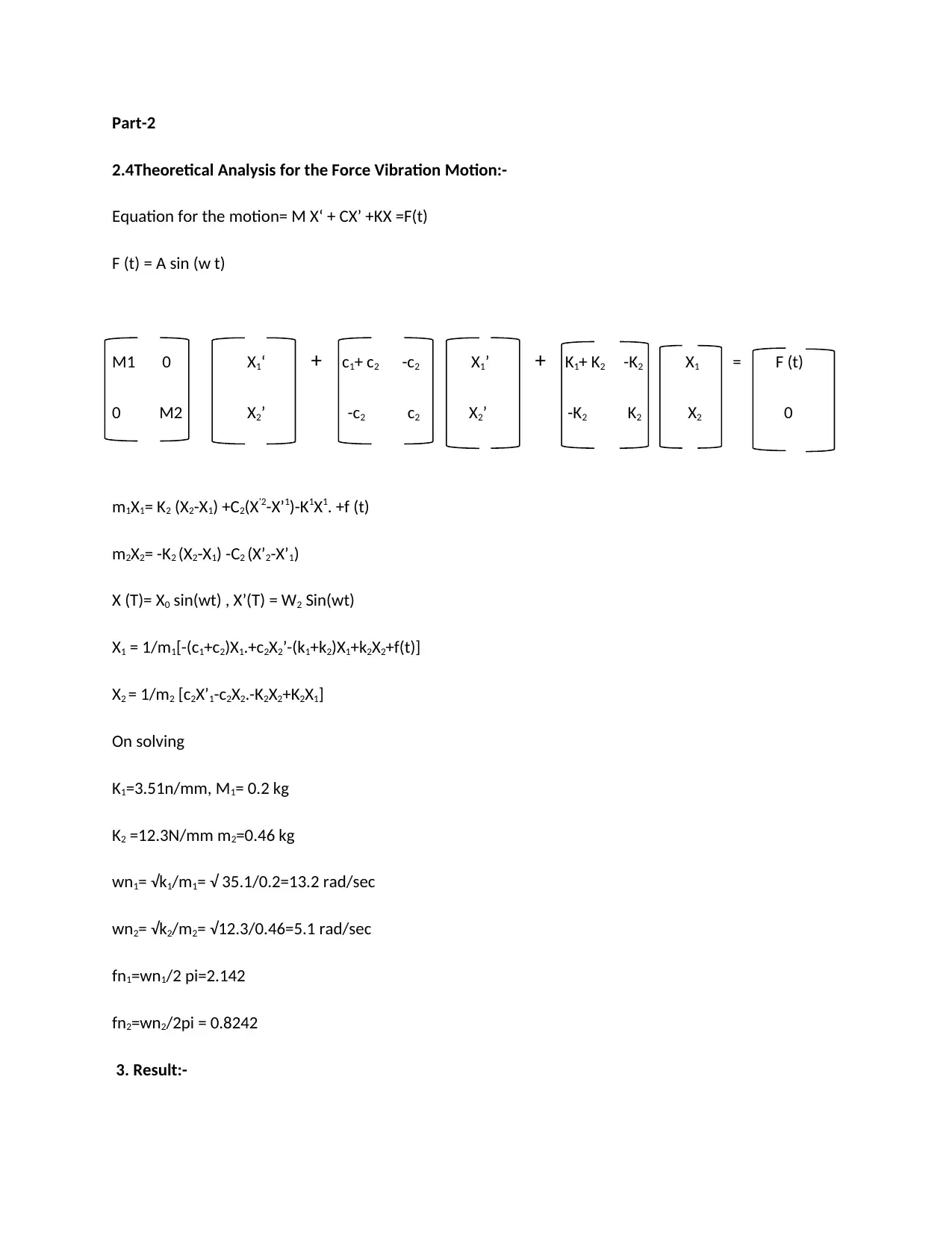
Part-2
2.4Theoretical Analysis for the Force Vibration Motion:-
Equation for the motion= M X‘ + CX’ +KX =F(t)
F (t) = A sin (w t)
M1 0 X1‘ + c1+ c2 -c2 X1’ + K1+ K2 -K2 X1 = F (t)
0 M2 X2’ -c2 c2 X2’ -K2 K2 X2 0
m1X1= K2 (X2-X1) +C2(X’2-X’1)-K1X1. +f (t)
m2X2= -K2 (X2-X1) -C2 (X’2-X’1)
X (T)= X0 sin(wt) , X’(T) = W2 Sin(wt)
X1 = 1/m1[-(c1+c2)X1.+c2X2’-(k1+k2)X1+k2X2+f(t)]
X2 = 1/m2 [c2X’1-c2X2.-K2X2+K2X1]
On solving
K1=3.51n/mm, M1= 0.2 kg
K2 =12.3N/mm m2=0.46 kg
wn1= √k1/m1= √ 35.1/0.2=13.2 rad/sec
wn2= √k2/m2= √12.3/0.46=5.1 rad/sec
fn1=wn1/2 pi=2.142
fn2=wn2/2pi = 0.8242
3. Result:-
2.4Theoretical Analysis for the Force Vibration Motion:-
Equation for the motion= M X‘ + CX’ +KX =F(t)
F (t) = A sin (w t)
M1 0 X1‘ + c1+ c2 -c2 X1’ + K1+ K2 -K2 X1 = F (t)
0 M2 X2’ -c2 c2 X2’ -K2 K2 X2 0
m1X1= K2 (X2-X1) +C2(X’2-X’1)-K1X1. +f (t)
m2X2= -K2 (X2-X1) -C2 (X’2-X’1)
X (T)= X0 sin(wt) , X’(T) = W2 Sin(wt)
X1 = 1/m1[-(c1+c2)X1.+c2X2’-(k1+k2)X1+k2X2+f(t)]
X2 = 1/m2 [c2X’1-c2X2.-K2X2+K2X1]
On solving
K1=3.51n/mm, M1= 0.2 kg
K2 =12.3N/mm m2=0.46 kg
wn1= √k1/m1= √ 35.1/0.2=13.2 rad/sec
wn2= √k2/m2= √12.3/0.46=5.1 rad/sec
fn1=wn1/2 pi=2.142
fn2=wn2/2pi = 0.8242
3. Result:-

Conclusion:-
From the above study we analyzed the various parameters for the gloves and can reduce the risk of
vibration at the workplace.
From the above study we analyzed the various parameters for the gloves and can reduce the risk of
vibration at the workplace.
⊘ This is a preview!⊘
Do you want full access?
Subscribe today to unlock all pages.

Trusted by 1+ million students worldwide
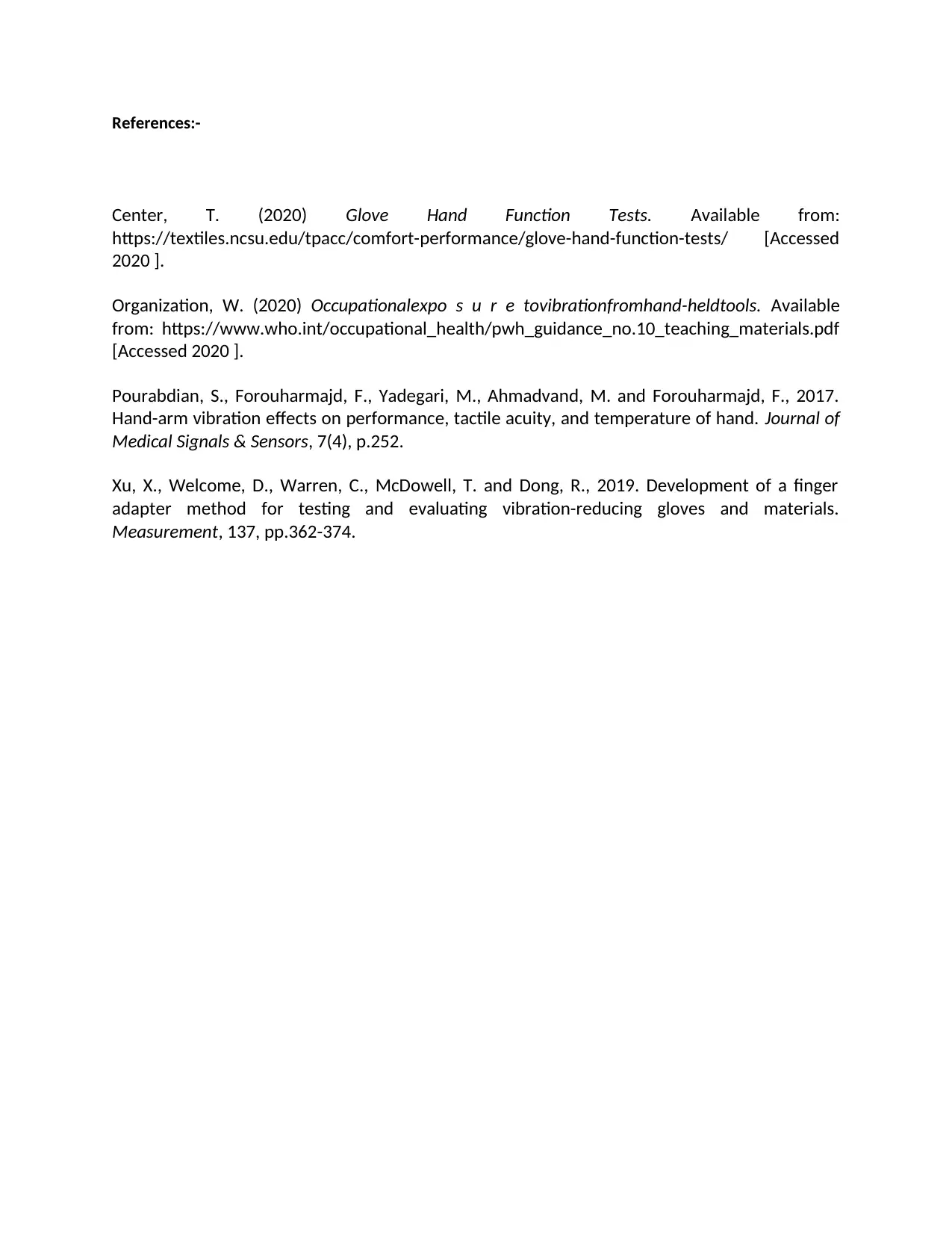
References:-
Center, T. (2020) Glove Hand Function Tests. Available from:
https://textiles.ncsu.edu/tpacc/comfort-performance/glove-hand-function-tests/ [Accessed
2020 ].
Organization, W. (2020) Occupationalexpo s u r e tovibrationfromhand-heldtools. Available
from: https://www.who.int/occupational_health/pwh_guidance_no.10_teaching_materials.pdf
[Accessed 2020 ].
Pourabdian, S., Forouharmajd, F., Yadegari, M., Ahmadvand, M. and Forouharmajd, F., 2017.
Hand-arm vibration effects on performance, tactile acuity, and temperature of hand. Journal of
Medical Signals & Sensors, 7(4), p.252.
Xu, X., Welcome, D., Warren, C., McDowell, T. and Dong, R., 2019. Development of a finger
adapter method for testing and evaluating vibration-reducing gloves and materials.
Measurement, 137, pp.362-374.
Center, T. (2020) Glove Hand Function Tests. Available from:
https://textiles.ncsu.edu/tpacc/comfort-performance/glove-hand-function-tests/ [Accessed
2020 ].
Organization, W. (2020) Occupationalexpo s u r e tovibrationfromhand-heldtools. Available
from: https://www.who.int/occupational_health/pwh_guidance_no.10_teaching_materials.pdf
[Accessed 2020 ].
Pourabdian, S., Forouharmajd, F., Yadegari, M., Ahmadvand, M. and Forouharmajd, F., 2017.
Hand-arm vibration effects on performance, tactile acuity, and temperature of hand. Journal of
Medical Signals & Sensors, 7(4), p.252.
Xu, X., Welcome, D., Warren, C., McDowell, T. and Dong, R., 2019. Development of a finger
adapter method for testing and evaluating vibration-reducing gloves and materials.
Measurement, 137, pp.362-374.
1 out of 7
Your All-in-One AI-Powered Toolkit for Academic Success.
+13062052269
info@desklib.com
Available 24*7 on WhatsApp / Email
![[object Object]](/_next/static/media/star-bottom.7253800d.svg)
Unlock your academic potential
Copyright © 2020–2025 A2Z Services. All Rights Reserved. Developed and managed by ZUCOL.